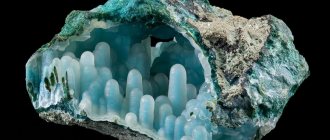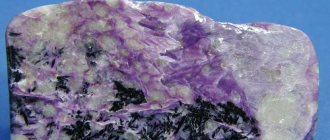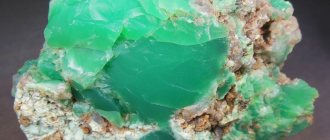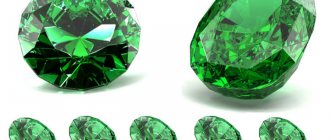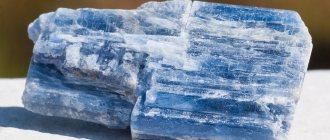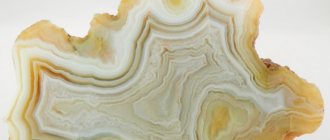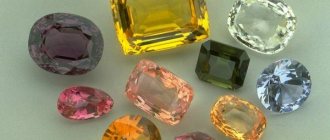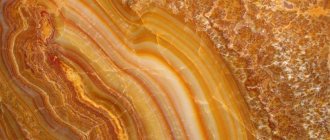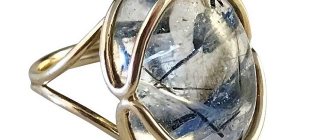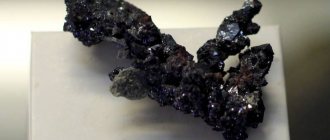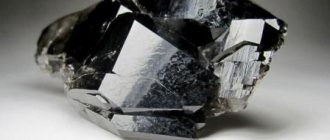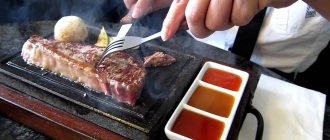Chalcedony is a semi-precious mineral, which, thanks to its wide range of shades, is very popular in the manufacture of jewelry and costume jewelry.
A ring or earrings with chalcedony will not only complement your look - they can become a real talisman for their owner , whose magical properties will ward off blues and depression.
History and origin
In museum exhibitions around the world you can find figurines, jewelry and interior elements made from the mineral and dating back several hundred years BC.
According to one of the most widespread legends, the stone was discovered by the ancient Greeks on the coast of the Sea of Marmara near the city of Chalcedon . It got its name from the name of the settlement.
The mineral was used in the manufacture of interior figures and bas-reliefs, carved gems with images of animals and people, cameos, carved seals - intaglios.
Interesting! In the Revelation of John the Theologian, the mineral is described as a stone decorating the gates and foundation of the walls of the New Jerusalem.
Unfortunately, the invasion of barbarian hordes wiped out the city from the face of the Earth, and the mineral was forgotten for a long time. Interest in it was revived again , when elements of wall decoration and sculpture began to be made from chalcedony.
The shine and poverty of chalcedony
Chalcedony (like jade, rock crystal, jadeite, flint, obsidian) is found by archaeologists in amulets and jewelry of ancient people. And not just decorations. In museums you can see chalcedony knives discovered by archaeologists during excavations of Paleolithic sites.
Chalcedony knife, 1200-1000 BC
Green chalcedony portrait bust of Julia Drusilla or Livia Livilla (sister of Caligula), made around 37-39 AD, British Museum
- The gem “participated” in the construction of the walls of the Heavenly City (according to the Bible).
- Painted stone has been found in Egyptian tombs.
- Pliny in his Natural History described the varieties of chalcedony.
- The first wave of popularity of the gem occurred in Antiquity. The ancient Greeks were unsurpassed stone cutters. The art of glyptics (stone carving) in those days reached unprecedented heights. And the structure of multi-layered varieties of chalcedony made it possible to turn stones into true works of art.
- With the collapse of the Roman Empire, cultural values disappeared and interest in the wonderful stone disappeared.
- Chalcedony is mentioned in the works of G. Agricola.
- The second wave of “chalcedony fever” covered the 17th-19th centuries. Classicism came into fashion, and interest in ancient culture was revived. A rich layer of citizens enthusiastically decorated their homes with mosaics, furniture inlaid with colored stones, figurines, vases and other cute little things. Lovers and connoisseurs of antiquities traveled to Italy not only to bask in the sun, but also to expand their collections of antique jewelry.
- Some of them now decorate the halls of the Hermitage, Louvre and other lucky owners.
origin of name
We read from Bukanov:
“The old Russian name for chalcedony is perelift.” And again the Urals make us happy. Here you can find a special variety of agate - iridescence, in which the layers of chalcedony seem to “flow” in bizarre streams and stripes, and the color shimmers from white to bluish and yellowish-orange, reddish.
Versions of the origin of the name of the mineral:
- From the city of Kalchedon (Chalcedon) . At that time it belonged to Greece. Now territorially belongs to Turkey (Kadikoy district of Istanbul).
- From Carchedon (Carthage) . It was a port in North Africa. The stone was mined in Egypt and Syria, and from there it was delivered to Carthage. From the port, boats transported the gem throughout the Ecumene.
Physicochemical characteristics
Chalcedony belongs to the minerals of the quartz group , and the abundance of color options for the stone can be explained both by the territorial features of geological processes and by the variety of impurities.
Chemical formula: SiO2. Chalcedony is quite hard; on the Mohs scale it is rated from 6 to 7 units.
The density of the stone is from 2.58 to 2.64 g/cm3. The mineral has no cleavage, the fracture is uneven, sometimes shell-like, trigonal system. Matte shine, imperfect transparency, cloudy. There are a lot of shade variations.
GENERAL CHARACTERISTICS OF CHALcedony STONE
The modern name of the mineral comes from the Greek toponym Chalcedon. This is an ancient port city on the Sea of Marmara: in what is now Turkey. Chalcedony was found in the vicinity of the polis and began to be used to create jewelry and in magical rituals. In ancient times, stone was used to make dishes that protected against poisons.
Chalcedony is usually called specific jewelry and ornamental minerals of blue and blue color. The same name is given to varieties that are similar in composition and structure.
Members of the family differ in color palette and pattern. There are own names for individual samples. For example, chrysoprase is a greenish variety.
Chalcedony
History of origin and deposit
Chalcedony, which appears as a blue, white, red, black or green stone, was formed by the crystallization of magma. Less commonly, the appearance of a mineral in the earth's crust is associated with weathering, sedimentation and crystallization. solutions. Found in metamorphic rocks and petrified wood.
Even 5-6 thousand years ago, jewelry made of chalcedony - beads, earrings, pendants, tiaras - certainly complemented the outfit on holidays and everyday life. The most expensive jewelry was made from carnelian, which was mined in India. Gems were worn as pendants, threads of beads were wrapped around the neck, hips, decorated the forehead, and trimmed cloaks.
Chalcedony is one of the 12 stones given to Moses, who led the people of Israel from Ancient Egypt. During the Renaissance, men's gem jewelry symbolized physical strength, health, and success. Wealthy women and urban fashionistas always had earrings, beads, and necklaces made of this gem.
In Buddhism, stone has long been used to create statues of Buddha. In Tibet it is considered a symbol of purity, increasing the ability to concentrate and absorb important things. The healing properties of the mineral are described in ancient manuscripts.
Chalcedony deposits
Chalcedony is mined in India, Turkey, South Africa, USA, Canada, Russia (Moscow region, Siberia and Chukotka). Rich mineral deposits have been discovered in Uruguay, Brazil, India, and Sri Lanka. European deposits are located in Scotland, the Czech Republic, and Poland.
We recommend: TOP 9 shades of WHITE ONYX
Physico-chemical properties of chalcedony
Colored varieties belong to the group of jewelry and ornamental stones.
The composition is dominated by quartz and moganite, which arose during the melting and subsequent crystallization of silica.
The class of minerals is oxides.
Crystals - uniform in color or with transitions, zones, stripes.
Physical properties of the stone:
- hardness - from 6.5 to 7 units on the Mohs scale;
- fracture - shell-like or conchoidal;
- line - white or colorless;
- shine - waxy, dim;
- density - 2.6 g/cm3;
- translucency.
Aqua
The chemical composition is reflected by the formula SiO2.
The color is created by impurities of copper, manganese, iron, nickel and chromium.
The mineral is resistant to acids, with the exception of hydrofluoric acid.
Other properties: fibrous, porous, ability to change color.
Colors and varieties with photos
Mineralogy knows more than 100 varieties of chalcedony. Since in ancient times people named minerals not by their composition (few people knew about chemistry for a long time), but by their composition and appearance in general, each species has an individual name .
Green chalcedony
Better known as chrysoprase. The stone is apple green or emerald in color with a matte sheen, translucent or not at all transparent in light.
Jewelers love this mineral very much; they make rings, earrings, brooches and bracelets with inserts from it. Chrysoprase polishes well.
Interesting! Esotericists attribute magical properties to it and use it as a talisman that attracts good luck.
It is known that chrysoprase loses its color intensity when exposed to sunlight, but few people know that it can restore color in water.
Mtorolite is another variety of green chalcedony with a dense color. The stone is opaque, often monochromatic, but there are striped specimens. The mineral contains chromium, which causes its unique color.
Pink chalcedony
Carnelian, in Latin carnelian (dogwood berry). The intensity of the shade can vary from deep red to pink - this is due to the presence of iron oxides (hematite) in the mineral.
Under the influence of ultraviolet light, the stone loses its shade intensity and may acquire orange tones.
Interesting! There is a variety with a red tint - sarder.
Blue chalcedony
The most famous variety is sapphirine, although this species is quite rare. It has a high collection value , jewelry with it is very elegant and beautiful, although it has nothing to do with sapphire.
A stone with a beautiful blue tint, it is almost opaque, with a waxy thick shine. But under the influence of ultraviolet radiation and high temperatures it can lose all its charm.
White chalcedony
Otherwise known as cacholong, or milky opal. A rare gem of a milky white hue with a porous structure.
Red chalcedony
Heliotrope, or bloody jasper. The mineral is a dark shade of green with bloody inclusions.
This stone has been known since ancient times; there are mentions of it in the works of Pliny . Heliotrope stains are also called “blood of Christ.” The mineral was used to make religious attributes.
Red varieties include Dzhambul chalcedony , named after the deposit where the mineral was discovered. The stone is translucent, and the intensity of the shade varies from dark red to pink.
Striped Chalcedony
Perhaps the most famous representative of chalcedony is agate. A very beautiful layered chalcedony, whose colors and arrangement of lines are literally mesmerizing.
Highlight:
- Brazilian agate, whose distinctive feature is the finest layering;
- dendritic - the pattern of the mineral is similar to a forest thicket or the crown of a tree;
- mossy—the location and shape of the lines of the pattern resembles moss;
- stellate;
- disk;
- bastion
Black chalcedony
Onyx. It is difficult to call this mineral black in the full sense; this is a historical name.
In fact, its colors range from dark brown to deep blue with plane-parallel stripes of other colors . In jewelry, striped agate is dyed to obtain a uniform color.
Grape chalcedony
It consists of beautiful spherulites of all shades of purple. The nugget resembles a bunch of grapes and has high decorative qualities.
Lesser known varieties of chalcedony
Mirikit is a semi-precious stone, a type of gray chalcedony, decorated with spots of red hues.
Stefanik , or point agate, is a white/light gray stone with a red dot pattern.
Enrigus has light shades. It contains quartz and lutein. The unusual coloring became a ticket to the jewelry world.
The magical properties of chalcedony
From time immemorial , the stone was considered an assistant in matters of the heart ; its task is to attract a man’s attention and keep it.
In addition, the mineral, having positive energy, helps to cope with melancholy and depression, overcome the blues, believe in one’s strength, and attract good luck.
Different shades of color help enhance or suppress different character traits:
- gems of orange shades can awaken acting talent and enhance attractiveness;
- red and purple strengthen the will, increase energy reserves, evoke a thirst for movement and achievement;
- green minerals increase patience;
- blue reduces anger, suppresses outbursts of rage;
- brown will become a guarantor of stability.
View this post on Instagram
Posted by Handmade Jewelry (@formula_bijou) Aug 12, 2020 at 5:21 PDT
Medicinal properties
Since ancient times, all chalcedony has been used to treat skin diseases and feverish conditions . A common property of all minerals in this group is a beneficial effect on the nervous system.
Otherwise, the healing properties vary from variety to variety:
- onyx helps with liver and kidney diseases;
- heliotrope supports the heart muscle;
- the serder treats ulcers and open wounds;
- chrysoprase relieves weather dependence and stabilizes the condition of migraines;
- carnelian relieves toothaches;
- Hypotensive patients must have sapphirine;
- Agate helps people with respiratory diseases and reduces toothache.
APPLICATION IN DIFFERENT FIELDS
Chalcedony is used in jewelry to produce rings, bracelets, cameos, beads, seals and other items. The stone is popular as a keychain or amulet.
We recommend: All about the Aventurine stone
Pieces of the mineral are processed and used in the interior to decorate fireplaces, inlay picture frames and mirrors. They make figurines, vases, sinks, countertops, and tiles for bathrooms.
The magical properties of chalcedony
Esotericists and astrologers consider the stone strong, charged with positive energy. The magical properties of the gem help in difficult life situations, when the burden of problems weighs on you, you lack strength, and you are overcome by depression. In addition to strengthening fortitude in case of loss of strength and melancholy, chalcedony is able to pacify aggression and facilitates the achievement of harmony.
Chalcedony bracelet
This stone gives confidence, nobility and attractiveness to a woman.
Men are closer in spirit to his ability to make it easier to solve complex problems.
Amulets and amulets made of gems protect the owner from the evil eye and damage. There is a belief that a piece of chalcedony at the head of the marital bed will ensure many years of a happy life together.
Healing properties of the stone
Some healing actions are directly associated with magical properties. If the mineral protects it from damage and the evil eye, then the owner will not be at risk of diseases associated with them.
Sometimes the name “speaker’s stone” is mentioned because chalcedony affects the strength of the voice and resonance. The mineral supports throat health and helps with infectious and inflammatory diseases of the respiratory tract.
Authentication
Methods of use in lithotherapy:
- Apply to the affected area.
- Place under your pillow at night.
- Drink medicinal water obtained using the stone.
- Wear a chalcedony amulet.
Chalcedony is universal and can be used for other complaints. The stone is useful for diseases of the thyroid gland, mammary glands, hormonal disorders during menopause, neuroses, and hypotension.
Who is suitable according to zodiac sign and name
Astrologers, like lithotherapists, are convinced that chalcedony stone has universal properties. It is advisable for representatives of different zodiac signs to choose for themselves certain color varieties of gems that best suit their horoscope.
- Taurus and Libra are recommended to wear amulets and jewelry made from light-colored minerals - white, blue, pink.
- Scorpios are protected from misfortunes and diseases by black varieties.
- Astrologers also advise Capricorns to wear dark-colored gems.
- Golden and yellow types of the mineral will help Leo and Gemini.
- Virgos and Cancers need green and yellow stones.
- Chalcedony of any color is suitable for Sagittarius.
- Aquarius is better off choosing chrysoprase.
- Jasper suits Aries and Pisces.
We recommend: MAORI FIGURES that change destiny
If you don’t have chalcedony of a suitable color, don’t despair. Varieties of the universal gem exhibit the basic properties of the “ancestor” of the group.
By purchasing products with stone, using the mineral in the interior, you can, with the help of a source of additional energy, increase your chances of success in business, attract good luck, become a more charming woman, a strong and resilient man.
Chalcedony is suitable for people whose names are Valeria, Inga, Karina, Irina, Lyubov, Ksenia, Raisa, Alexander, Bogdan, Georgy.
Chalcedony products
Chalcedony is used both for the manufacture of costume jewelry and in the production of jewelry.
What stones does it go with?
Considering that all the stones of the group have a strong personality, jewelers rarely combine them with other stones and minerals.
Indeed, not all stones can tolerate proximity to chalcedony without conflicts (the exception would be cubic zirconia , which does not have its own energy).
Chalcedony shows itself neutrally only in tandem with stones belonging to the elements of Earth and Air.
The mineral does not combine with:
- rock crystal;
- moonstone;
- coral;
- beryl.
View this post on Instagram
Posted by Jin | DZIN (@dzin_tlt) Aug 11, 2021 at 2:55 PDT
Decoration with mineral
The most incredible jewelry is made from chalcedony. The range is not limited to earrings and bracelets. of minerals , and brooches and rings are encrusted .
Ornamental grade stones are used to make pendants, beads, rosaries, decorative figurines and key rings .
How to wear and care
Chalcedony may lose its color intensity if it stays in the hot rays of the sun for a long time. Excessive heating is also contraindicated for him. It is worth protecting the mineral from the effects of household chemicals and cosmetics .
Important! Chalcedony needs to rest from time to time to restore its energy. Therefore, the owner needs to leave the stone in the water for a while or let it “bathe” in the moon’s rays.
Who is it suitable for?
- Sailors, fishermen traveling on water (sea, rivers, lakes).
- Will the devil break his leg in your little one's room? Give your child a chalcedony amulet. M. Loiri assures that the stone will gradually teach your child to be neat.
- Pregnant women. The experience of our ancestors says that the gem will help you calmly bear and easily give birth to a healthy child.
- Readers, teachers, speakers - those who like or have to talk a lot.
Zodiac signs
- Good for Capricorn and Virgo. If Saturn is prominent in your natal chart, feel free to wear chalcedony jewelry.
- J. Stone advises people born under the sign of Sagittarius to wear chalcedony.
- For Aquarians of the third decade, the gem will provide all available help.
Is Chalcedony Right for You?
Not really
Element
Water
Air
Earth
Planets
Neptune
Saturn
Energy
Yin
Price
The price of chalcedony stones depends on several factors:
- types of stone, its color, size;
- metal that forms the frame.
So, for a figurine made from a common stone you can pay about 500 rubles , and gold earrings with agate can cost about 20 thousand rubles .
Areas of application
- Chalcedony has long been used for jewelry. Until now, some varieties of gems are highly valued.
- The mineral is used in the production of tiles (even for wet rooms).
- Furniture inlay, decorative objects (vases, figurines, glyptics).
- It is almost never used for “serious matters”. Stone is used to make mortars for grinding solid materials in the production of analytical balances.
How to distinguish an original from a fake
Inexpensive minerals are rarely counterfeited, since it is unreasonably expensive. But rare varieties with jewelry value are often replaced with plastic or glass .
You can detect a fake:
- By weight. Natural stone is always heavier than glass or plastic.
- Temperature change . The stone, even in a warm room, is a little cool. It heats up slowly from the warmth of your hand, changing the temperature evenly.
- A natural gem will always have inclusions or air bubbles in its structure, which can be seen in the light or under a magnifying glass.
- A mineral of natural origin will never be homogeneous . Its shades will have specks of a lighter or darker shade.
Talismans and amulets
Chalcedony is a stone of people who devote themselves to science. It helps increase concentration, strengthens willpower and helps achieve goals.
This mineral is considered the patron saint of sailors : sailors believed that a chalcedony amulet would help them find their way to home.
Agate talismans (bracelets, pendants or beads) help children avoid injury.
Chalcedony is also a stone of women . It enhances natural female magnetism and helps to find true love.
